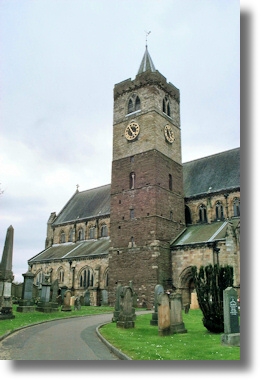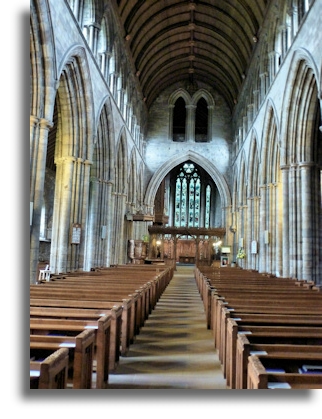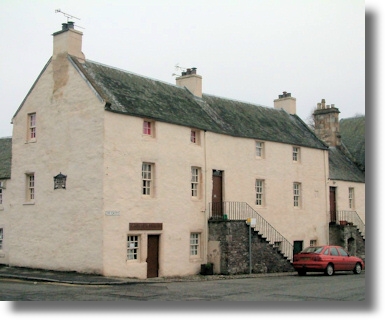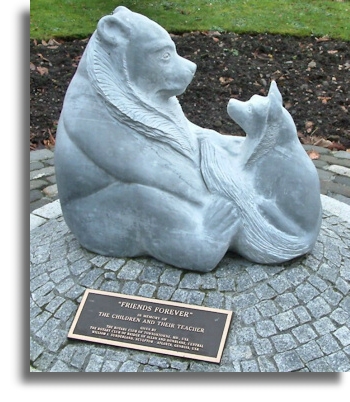

Dunblane Cathedral - Early History
Dunblane (fort of Blane) is named is named after St Blane, who is believed to have been born in the island of Bute in the kingdom of Strathclyde in the latter half of the 6th century. He was educated in Ireland and St Kentigern (also known as Mungo) was establishing his church in Glasgow at around this time.
Blane established a monastery in Bute in the Firth of Clyde and then moved into the land of the Picts who inhabited the country north of the river Forth. Dunblane is five miles north of Stirling which, even in those days, would have been an important river crossing on the Forth.
Blane is said to have been given a dun (or fort) as a place to build his monastery, near the Allan Water which flows through Strathallan further north.
Although Blane was a bishop, the bishopric did not continue after his death in 590AD. Muthill, 10/12 miles further north, was a serious rival for the location of a cathedral of the "bishop of Strathearn". But when King David I (who reigned from 1124 to 1153) reorganised the Catholic church in Scotland he established the bishopric at Dunblane, rather than Muthill, with the support of the Earls of Strathearn who became the patrons of the diocese.
The carving representing St Blane, which is illustrated here, comes from the pulpit in the present-day cathedral.

A stone church (earlier ones may well have been made of wood) was built in the 12th century. Little remains of this building but the lower four floors of the tower (seen here) was built around the time of King David. Originally it may have been detached from the church and would have been used defensively as well as housing the belfry.
In 1233, a Dominican Friar named Clement became the bishop. By that time the ecclesiastical buildings were half-ruined and he set about demolishing them and building the fine church we have today. Although he probably did not see it completed, he established the magnificently proportioned nave with its aisles. Clement died in 1258 and his tomb, with what is believed to be his effigy, is still in the choir of the cathedral.

Dunblane Becomes a Magnificent Cathedral
Subsequent bishops added to the size and magnificence of the cathedral. The tower was increased in height by Bishop James Chisholm (1487-1545) and the wall bears his coat of arms. He was also responsible for the wonderfully carved stalls which are now at the west end of the nave.
The cathedral eventually had ten altars (as well as a high altar) plus statues, paintings and stained glass windows. But when the Reformation came along in the 16th century they were all swept away as they were considered to be signs of idolatry. The Presbyterian church had no need for the large number of clergy and the ceremonies of the Roman Catholic church and as a parish church only the former choir continued in use. The rest of the building was allowed to deteriorate and by 1600 the roof of the nave had collapsed.
Restoration

Restoration work on the cathedral was eventually begun towards the end of the 19th century. A leading Scottish architect, Sir Rowand Anderson masterminded the work. After re-roofing the nave he reconstructed the windows and gradually, over the years, magnificent new stained glass was installed, a feature for which the cathedral is understandably famous.
Pictured on the left are the windows in the south choir; they are the work of Louis Davis. They represent fire, storms, cold and snow. At the foot of the window are the names of the five members of Robert Falcon Scott's ill-fated expedition to the South Pole who lost their lives in 1912.
 The impressive pulpit (shown on the right of this page) dates from the 19th century restoration and has seven finely carved figures reflecting the history of the cathedral. St Blane is of course featured along with King David I who founded the bishopric of Dunblane, Clement, Bishop of Dunblane from 1233-1258 who built the original stone building and John Knox, the main inspiration of the Reformation in Scotland.
The impressive pulpit (shown on the right of this page) dates from the 19th century restoration and has seven finely carved figures reflecting the history of the cathedral. St Blane is of course featured along with King David I who founded the bishopric of Dunblane, Clement, Bishop of Dunblane from 1233-1258 who built the original stone building and John Knox, the main inspiration of the Reformation in Scotland.
Although the cathedral is used by the people of Dunblane as a parish church, the building is now owned by the state and is maintained by Historic Scotland. As such, it is open to the public and there is sometimes a guide available to answer questions. Opening hours vary depending on the time of year and it is best to check in advance.

Dunblane's Pictish Associations
Dunblane's origins in the days of the Picts are recalled by a finely carved Pictish cross which is displayed in the cathedral. The cross was found beneath the floor of the chapter house in 1873. It dates from the 9th century and may have been associated with the early church.
On one side is a Celtic cross and, as is often the case with this type of stonework, the other side has representations of Pictish symbols. At the top there are two mythical beasts facing one another on their hind legs and below there is an unusual square pattern surrounding a square figure filled with five bosses like the dots on dice. There is then a small, ringed, Celtic cross on the left, with a large horseman with a spear and a dog below. Below all that is a disc decorated with a cross and spirals. At the very foot is a man with a staff, lying with his feet pointing towards another spiral.
Dunblane Museum

Just across the road from Dunblane Cathedral is the local Dunblane Museum. Originally called the Dunblane Cathedral Museum when it opened in 1943, it's not particularly large but it is packed with exhibits and information about the history of the cathedral (including a complete set of "The Journal of the Society of Friends of Dunblane Cathedral" from its creation in 1930, containing numerous articles about the church and local history). Other historical subjects covered by the museum include a treasure trove of coins found on a farm near Dunblane and a recently created garden demonstrates gardens throughout the ages and retains some original features including a 17th century well.

Dunblane Massacre
The incidence of crimes involving hand guns in the UK is mercifully low despite (or more likely because) most police are unarmed (and don't want to be armed). So there is perhaps a greater reaction here when there is an incident involving firearms, such as the massacre of sixteen children and one adult at Dunblane Primary School on 13 March 1996. The gunman, 43-year-old Thomas Hamilton, entered the school armed with four handguns (legally licensed at the time), and after wildly shooting the children and a teacher, he committed suicide. It was one of the worst criminal acts involving firearms in the history of the entire United Kingdom, far less Scotland.
Since the event, additional laws were passed which effectively made private ownership of handguns illegal in the United Kingdom. The shocked local community of Dunblane also rallied round and decided to create a memorial garden so that the incident and those who lost their lives would always be remembered. The sculpture shown here is part of that memorial. There is also another memorial in Dunblane Cathedral to commemorate the tragedy that struck the town in 1996.
Andy Murray

Although he doesn't talk about it much, top class tennis player Andy Murray (born in Dunblane on 15 May 1987) was a pupil at Dunblane Primary when the gunman struck in 1996. But at the age of 15, Andy moved abroad to progress his tennis career and since then has travelled the world advancing his place in the world of tennis.
Andrew "Andy" Murray is currently (September 2012) ranked No. 3 in the world and is of course also the British No. 1 player. He achieved a top-10 ranking for the first time in 2007, and reached a career peak of World No. 2 from 17 to 31 August 2009. He has been the runner-up in four singles Grand Slam finals: the 2008 US Open, the 2010 Australian Open, the 2011 Australian Open, and 2012 Wimbledon, losing three to Roger Federer and one to Novak Djokovic. In 2011, Murray became the seventh player in the Open Era to reach the semi-finals of all four Grand Slam tournaments in one year.
Then in September 2012, he became the first British male player since 1936 to win a Grand Slam singles tournament, when he defeated Novak Djokovic in five sets at the US Open Tennis Championship in New York. This title made him the only British male to become a Grand Slam champion during the Open Era. His coach Ivan Lendl, engaged at the start of 2012, had also won his first Grand Slam after failing in four previous finals.
Earlier in the year at the 2012 London Olympics, Murray defeated Roger Federer in straight sets to win the gold medal in the men's singles, becoming the first British Olympic tennis champion in over 100 years. He also won a silver medal in the mixed doubles at the 2012 Olympics.
The UK Post Office marked the success of all the Team GB gold medallists at the London Olympics by painting one post box gold in a town associated with the successful medallist. Of course Andy Murray's gold post box was painted in Dunblane (see illustration). The gold colour is expected to remain for just six months, however, and will then revert to the standard red.



